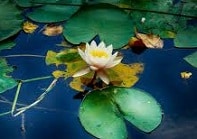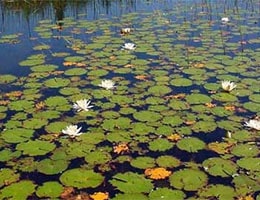 The Sanskrit term nīlautpala passed into pelvi as nīlōpal , which in turn came into Arabic as naylūfar . The concept arrived in our language as a water lily : this is the name for an aquatic plant that belongs to the family group of Nymphaea .
The Sanskrit term nīlautpala passed into pelvi as nīlōpal , which in turn came into Arabic as naylūfar . The concept arrived in our language as a water lily : this is the name for an aquatic plant that belongs to the family group of Nymphaea .
Water lilies have gnarled and extensive rhizomes; rounded leaves that reach the surface of the water; whitish flowers; and globe-like fruits. The leaves and flowers , therefore, can be seen with the naked eye since they float.
It is important to mention that, beyond the species , the notion of water lily is usually used to name any aquatic plant that has flowers . Water lilies can be found in rivers, swamps, ponds and lakes, to name a few possibilities, with their roots fixed to the bottom.
In ancient times , the Egyptians attributed symbolism to the water lilies that grew in the Nile River . As the flowers open during the day and close at night, the plant was linked to issues of the gods and death, more specifically to the separation of the gods and beliefs related to the afterlife.
The name given to water lilies in ancient Egypt was "lotuses", although we should not think about the lotus genus , in which around one hundred and fifty species are recognized but are related to around three hundred more that have not yet been officially accepted. If we look at the capitals of the columns of an Egyptian temple, it is common to find this flower in its motif.
At the beginning of the third millennium, scientists discovered that the water lily called the blue lotus has psychedelic properties, and it is very likely that the ancient Egyptians knew this too, especially because they used it in some of their ceremonies, something that can be seen in many graphic representations. that they left captured on their walls. In the tomb of Ramses II , for example, remains of this plant were found.
On a terracotta plaque of Syrian origin made between the 14th and 13th centuries BC. C., we can see the goddess Asherah with two water lilies. It also appears on an ivory panel that belongs to the period between the 9th and 8th centuries BC. C., where the god Horus is seen sitting on one of his flowers, next to which there are two angels.
 It is important to note that interest in water lilies did not die with ancient civilizations, but rather persisted and adapted to the characteristics of each era. In more recent times, its role is not found in rituals but in ornamentation and alternative medicine . Claude Monet , the French painter born in the second half of the 19th century, gave this plant a great role in several of his works.
It is important to note that interest in water lilies did not die with ancient civilizations, but rather persisted and adapted to the characteristics of each era. In more recent times, its role is not found in rituals but in ornamentation and alternative medicine . Claude Monet , the French painter born in the second half of the 19th century, gave this plant a great role in several of his works.
Regarding its medicinal properties, water lily can act as an astringent to wash the genital area in treatments against leucorrhoea, gonorrhea and also uterine cancer. On the other hand, it serves as a mouthwash to relieve infections and abscesses, if its root is decoated. In case of inflammation or burns on the skin, its application is also beneficial.
It should be noted that water lilies demand stagnant water or water with little current . Because their roots can measure more than four meters, they have the ability to grow in deep water. The first leaves that emerge are the largest, and then the elongated ones appear that float and are observed on the surface .
Although it depends on each species, water lilies generally prefer warm waters. Once the leaves die, the ideal is to extract them so that the water is not contaminated by decomposition.
